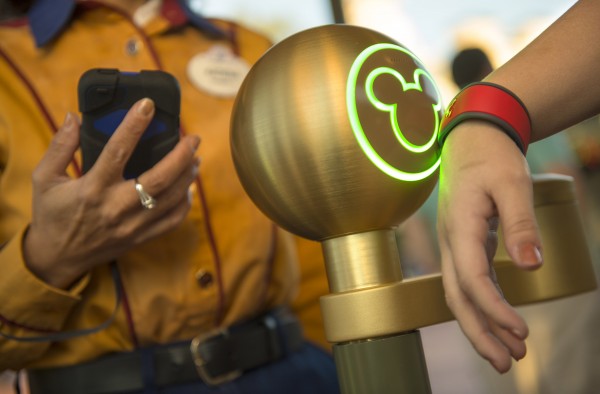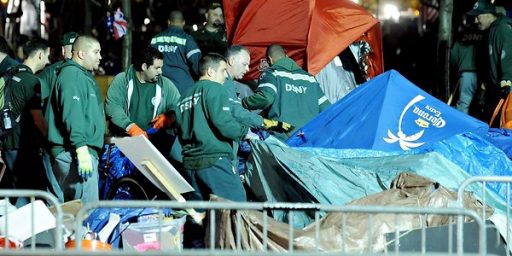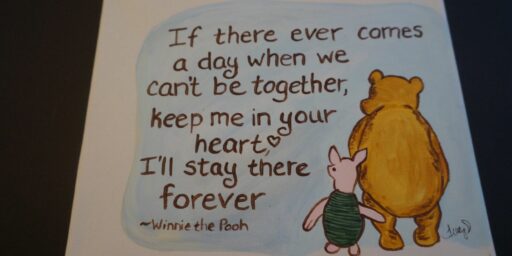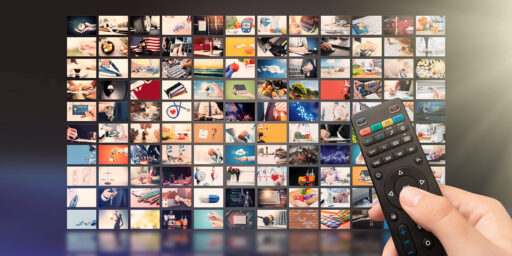Big Brother Meets Mickey Mouse
Ubiquitous tracking isn't all bad.
While there’s plenty of downside to the ubiquitous tracking that’s now normal for those of us who live in technologically advanced societies, there’s plenty of upside, too. A couple of stories I’ve read the last couple of days highlight the latter.
The Verge (“Tracking travelers’ phones let Cincinnati airport cut security line waits by a third“):
Going through airport security is a miserable experience, but airports are at least starting to figure out ways to get you through the line quicker. Cincinnati/Northern Kentucky International Airport says that the median wait time in its security lines has dropped by a third, going from 13.2 minutes to 8.9 minutes, after installing a system that tracks travelers’ phones to estimate how much traffic each line has. The system allows the airport to display to passengers how long the wait in each of its security lines is. It also allows the airport to adjust its resources to respond to demand.
The airport’s tracking system, made by Blip Systems, looks for devices over Wi-Fi and Bluetooth. Blip Systems says that it collects each device’s unique identifier (MAC address) and then uses that information to determine how many people are present in a given area. There are certainly some security concerns related to tracking like that, but the information it’s collecting can only show so much — that your device is present — and, theoretically, that’s increasingly little. Blip Systems also says that it anonymizes all data. Plus, everyone is already going through airport security, so it’s not like the system would be breaching some bastion of privacy.
The slight lessening of wait times at airports with wait times that are exceedingly modest to begin with (I mean, really, saving 4 minutes per visit isn’t that big a deal unless you’re a very frequent flier, indeed), the potential here is interesting.
Cincinnati/Northern Kentucky International Airport installed the system over the summer, supposedly becoming the first airport in the US to do so. It isn’t the first airport with the system worldwide, however. In an article last June, Bloomberg noted that it had already been installed in 20 airports, including in Amsterdam, Dubai, and Toronto. And improving security lines may be just the start. Bloomberg reports that Blip Systems believes its trackers could eventually be used to determine how many people are in different airport stores and restaurants, potentially even tracking movement around a terminal. That may be less appealing to travelers, but it’s hard to argue much with cutting down security lines.
But Cliff Kuang’s extensive Wired feature (“DISNEY’S $1 BILLION BET ON A MAGICAL WRISTBAND“) really got my attention.
If you’re wearing your Disney MagicBand and you’ve made a reservation, a host will greet you at the drawbridge and already know your name—Welcome Mr. Tanner! She’ll be followed by another smiling person—Sit anywhere you like! Neither will mention that, by some mysterious power, your food will find you.
“It’s like magic!” a woman says to her family as they sit. “How do they find our table?” The dining hall, inspired by Beauty and the Beast, features Baroque details but feels like a large, orderly cafeteria. The couple’s young son flits around the table, like a moth. After a few minutes, he settles into his chair without actually sitting down, as kids often do. Soon, their food arrives exactly as promised, delivered by a smiling young man pushing an ornately carved serving cart that resembles a display case at an old museum.
Nice, I suppose, but not that big a deal. But it gets better.
Part of the trick lies in the clever way Disney teaches you to use them—and, by extension, how to use the park. It begins when you book your ticket online and pick your favorite rides. Disney’s servers crunch your preferences, then neatly package them into an itinerary calculated to keep the route between stops from being a slog—or a frustrating zig-zag back and forth across the park. Then, in the weeks before your trip, the wristband arrives in the mail, etched with your name—I’m yours, try me on. For kids, the MagicBand is akin to a Christmas present tucked under the tree, perfumed with the spice of anticipation. For parents, it’s a modest kind of superpower that wields access to the park.
If you sign up in advance for the so-called “Magical Express,” the MagicBand replaces all of the details and hassles of paper once you touch-down in Orlando. Express users can board a park-bound shuttle, and check into the hotel. They don’t have to mind their luggage, because each piece gets tagged at your home airport, so that it can follow you to your hotel, then your room. Once you arrive at the park, there are no tickets to hand over. Just tap your MagicBand at the gate and swipe onto the rides you’ve already reserved. If you’ve opted in on the web, the MagicBand is the only thing you need.
It’s amazing how much friction Disney has engineered away: There’s no need to rent a car or waste time at the baggage carousel. You don’t need to carry cash, because the MagicBand is linked to your credit card. You don’t need to wait in long lines. You don’t even have to go to the trouble of taking out your wallet when your kid grabs a stuffed Olaf, looks up at you, and promises to be good if you’ll just let them have this one thing, please.
This is just what the experience looks like to you, the visitor. For Disney, the MagicBands, the thousands of sensors they talk with, and the 100 systems linked together to create MyMagicPlus turn the park into a giant computer—streaming real-time data about where guests are, what they’re doing, and what they want. It’s designed to anticipate your desires.
That’s obviously pretty cool. But why would Disney spent a billion dollars trying to improve a park experience that was already pretty great, as evidenced by the throngs of people there even during off-peak times?
Staggs couches Disney’s goals for the MagicBand system in an old saw from Arthur C. Clarke. “Any sufficiently advanced technology is indistinguishable from magic,” he says. “That’s how we think of it. If we can get out of the way, our guests can create more memories.” He offers a story about how a program called Fast Passes once guaranteed a ride time at premier attractions like Space Mountain. It used to be that those passes were issued at the rides themselves, and stamped with a designated return time. You had to be there when it opened, because passes went quickly and unless you were a scheduling savant, it was hard to hold passes for more than one ride at a time. You’d see families waiting outside for the park to open, then fathers sprinting for a kiosk to get enough passes for everyone in the family. “I used to be that sprinter,” Staggs says.
You can see why he—and Disney—would be so keen on the bands. Instead of telling your kid that you’ll try to meet Elsa or ride It’s a Small World, Franklin says, “you get to be the hero, promising a ride or a meet-and-greet up front. Then you can be freer to experience the park more broadly. You’re freed to take advantage of more rides.” There is an elegant business logic here. By getting people exploring beyond the park’s top attractions, overall use of the park goes up. People spend less time in line. They’re doing more, which means they’re spending more and remembering more. “The whole system gave Disney a way of understanding the business,” says Franklin, who stepped down last July as Disney’s executive vice president of next-generation experience. “Knowing we need more food here, how people are flowing through the park, how people are consuming the experiential product.”
It also allows Disney to optimize employees. The goal was to create a system that would essentially replace the time spent fiddling with payments and tickets for moments of personal interactions with visitors. The MagicBands and MyMagicPlus allow employees to “move past transactions, into an interactive space, where they can personalize the experience,” Crofton says. What started as a grand technology platform has inevitably changed the texture of the experience.
Meanwhile, the digital world—and the ease with which we carry it around in our phones—has filled our lives with new expectations and endless entertainment options. “I can’t think of a business that isn’t affected by more choice and more access to information and an increasing desire for personalization,” says Staggs. So if you’re a theme park, you have a strange dilemma that echoes the dilemmas we face in our digital lives. “Walt Disney World is vast. There’s more to do than you could do in a month,” Staggs says. “That choice is overwhelming.”
In fact, it’s called the paradox of choice: You make people happier not by giving them more options but by stripping away as many as you can. The redesigned Disney World experience constrains choices by dispersing them, beginning long before the trip is under way. “There are missions in a vacation,” Staggs says. In other words, Disney knows that parents arrive to its parks thinking: We have to have tea with Cinderella, and where the hell is that Buzz Lightyear thing, anyway? In that way, the park isn’t a playground so much as a videogame, with bosses to be conquered at every level. The MagicBands let you simply set an agenda and let everything else flow around what you’ve selected. “It lets people’s vacations unfold naturally,” Staggs says. “The ability to plan and personalize has given way to spontaneity.” And that feeling of ease, and whatever flows from it, just might make you more apt to come back.
Disney was already better at this than any of the competitors and by a mile. Going to one of the non-Disney parks in Orlando is always a big let-down, especially in the midst of a week going to the Disney parks. Not only had Disney figured out how to herd huge numbers of people through the queues more efficiently than anyone else even before the magic bands, but they’d figured out how to make the lines themselves relatively entertaining. Still, in an era where even five minutes of time not being entertained is intolerable because of the increased expectations created by our technology, Disney believed they needed to get even better.
Will this concept spread beyond theme parks? Kuang thinks it might.
Will the world at large ever become something akin to Disney World, loaded with sensors attuned to our every move, designed to free us? There are signs. It’s already starting to appear on Disney cruise ships, and Staggs says airlines, sports leagues, and sports teams have asked about the technology. “We’re just at the beginning of understanding what to do with this,” he says. What Staggs doesn’t share, but what former team members do, is that Disney already has conceived, designed, and engineered many more features that seem to border on science fiction—features even more ambitious than delivering your food to you without your having to ask.
The MagicBand contains sensors that let guests swipe onto rides and allow Disney to pinpoint their location. At Be Our Guest, they’re what enable the radios in the table and ceiling to triangulate your location so your server can find you. If Disney decides to install those sensors throughout the park, a new world of data opens up. They could have Mickey and Snow White find you. They might use the park’s myriad cameras to capture candid moments of your family—enjoying rides, meeting Snow White—and stitch them together into a personalized film. (The product teams called this the Story Engine.) But they might also know when you’ve waited too long in line and email you a coupon for free ice cream or a pass to another ride. And with that, they’ll have hooked the white whale of customer service: Turning a negative experience into a positive one. It recasts your memories of a place—that’s why casinos comp you drinks and shows when you lose at the tables.
Though Franklin wouldn’t comment on the particulars of these possibilities, he did offer an intriguing summary of them. “What people call the Internet of Things is just a technological underpinning that misses the point, ” he says. “This is about the experiential Internet. The guest doesn’t need to know how it happened. It’s about the magic of the food arriving.”
Not exactly the flying cars we were promised, but pretty cool nonetheless.







Have you done Disneyworld with your daughters yet? It just occurred to me that both my kids are now sufficiently grown that I will never, ever need to do it again. If it wasn’t 9:00 AM I might have a celebratory beverage.
Am I the only one that doesn’t want strangers to greet me by name?
@michael reynolds: I’ve taken my oldest, now 6, to the parks a couple times and both on a Disney cruise once. We’re going again at the end of May.
It’s not a bad experience, really, except for the crowds. They make it pretty easy to ditch the kids for the evening and enjoy adults time, too. (Moreso on the cruise than the parks, but you can do it there, too.)
I took our kids four years ago with the express understanding that this was it. I do not find this to be my kind of vacation, and technology to get me to more lines (oh, yes there will be lines) does not alter that appeal one bit. You can ride every attraction in Magic Kingdom in one day, but it is a marathon, built on planning and persistence. Why would you want to do that, other than as a feet of skill?
Some of this technology was available then. We used the Magic Express so that our luggage checked-in at the airport was delivered to our rooms at the resort. Still waited about a half hour for the airport shuttle to arrive, which I understand is not bad. Our room access was with a wrist band, that only once needed to be re-activated. Think about that if you don’t want to take a credit card to the parks.
Oh yeah, my wife says we’re going to Magic Kingdom for Thanksgiving because the oldest will be performing in a marching band parade. Of mouse and man . . .Gang aft agley, An’ lea’e us nought but grief an’ pain.
@PD Shaw:
I’m with you. I’ve adjusted to the fact that room service always knows my name. That’s right, I want a second dessert. And, yes, more Scotch. My pleasure, Mr. Reynolds. But I don’t need Disney creatures calling me by name.
@michael reynolds:
The worst week of my life – and that includes the week that I took the NY bar exam – was spent at DisneyWorld.
It will never be repeated.
I took my daughter two years ago for the first time (she was 6) and she had an amazing time. We did a lot of what you describe above (we had cards instead of bands). Booked our flight and hotel and tickets all at once, which was cheaper than doing them individually. We had to plan our park days a bit, but it went smoother than I could have imagined (especially as you can get tickets to popular rides hours in advance). I’m hoping more places will adopt this tech. It really does make everything so much more enjoyable — for the employees as well, who would rather spend time interacting with guests than counting tickets.
The real amazing thing was that I accidentally left our backpack at a bus stop. It had my daughter’s princess autograph book in it so this was nearly a disaster. We were pretty glum until a Disney employee knocked on our hotel door and had the backpack in hand. They’d found our name in it and instantly looked up where we were. I thought my wife was going to run off with him. And my daughter declared I’d earned back all my “daddy medals” from taking her around Epcot all day.
@HarvardLaw92:
July. Temperature just three degrees cooler than the surface of the sun. Stuck in line outside Small World. Listening to that f–king song. Contemplating murder.
I last went to Disneyland on a freakish cold day in the southland when the park was nearly deserted. No line at Pirates of the Caribbean, walk up to the front, and hop in a boat. I enjoyed the parade that evening and got some nice photos. When I left, I remember thinking that I really never need to visit Disneyland again.
@PD Shaw:
My grandparents lived in Jupiter, so my frugal parents always tried to do Disney on the cheap. Drive up one day, do as much of the Magic Kingdom as possible. Spend a night at a non-Disney resort (“But they have a pool” said my parents) and then do as much of Epcot as possible and then go home. It was exhausting.
My girlfriend has never been to Disney. Her parents felt it too non-educational. She went to places like Peru, Mozambique, or Provence. She has zero in the way of happy memories. I feel that we will end up at Disney, but hopefully only once.
@michael reynolds:
Exactly my experience as well, except we went in August. I was standing there in a line that reached to Spain, sweating to the point that my underwear was wet, wondering for the 3,000th time that day why we hadn’t gotten Golden Retrievers instead of having kids.
I was halfway contemplating asking strangers to shoot me in the face. Never again …
@michael reynolds: @Modulo Myself: @HarvardLaw92: I’ve only been three times, twice for 5-6 days in May and once for a day in November en route to a cruise. It’s already pretty hot in late May, but certainly bearable. They’d have to pay me to go in July.
High School Grad Night for Southern California high schools, at least in the early 80s, meant an overnight adventure at Disneyland. The park closed at 6 PM, we arrived around 7 – and stayed until 6 AM the next morning. There was a one-hit-wonder all-female rock band on the island playing for us, and I still remember it never got dark outside. Not too crowded so it was easy to do everything.
Contrast that to last fall when we took my 3 year old granddaughter, on a Tuesday, during the school year. After paying $15 to park the car a couple of miles from the park in an official Disney lot, it was so crowded and miserable that the park almost closed their doors mid-afternoon due to capacity attendance. When you get 90,000 people each paying ~$100 to be there that day – plus the aforementioned parking, ice cream, Olaf dolls and $6 bottles of water, well, the math is mind boggling – I’m certain they are in the neighborhood of ten-fifteen million dollars per day in revenue. That’s not even counting Club 33 revenue
If this technology lets those 90K customers have a better time – and spend even a bit more money, it’s not hard to get their billion-dollars back pretty quickly.
@Tony W: Yup. And Disneyland is the little park! Walt Disney World dwarfs it, with multiple theme parks as part of the massive property.
Then again, the original benefits from better weather and being more compact; you can easily walk 8-10 miles a day at Disney World.
Never been to any Disney park, as a child or an adult. I suppose we may go one day, but I don’t know, my daughter’s well into her adult life now and my son isn’t into anything Disney. Maybe we’ll do one of the cruises or something.
We could afford to go, I suppose, but we spend our vacation budget on trips to actual Germany rather than EPCOT Germany.
This technology is fascinating, though–simultaneously awesome and a bit creepy. I have no doubt Disney’s going to push it for all they’re worth and there will be plenty of other adopters as well.
@Modulo Myself: If you can avoid school vacation days, by going in May or September, the crowds shouldn’t be bad. We went the first week of June, which is also Unofficial Gay Disney days, and it wasn’t bad with a little planning from internet websites. We avoided the theme parks on the “Gay” days, but I suspect that we largely benefited from schools being in session in different parts of the country.
@James Joyner: The best technological advance would be moving sidewalks at Epcot. That place is huge.
Drip, drip, drip.
@HarvardLaw92: I liked Disneyland and World and Epcot, all three–and I was university aged and older at the time of all three trips. On the other hand, I wasn’t a “Harvard Law” type (coming from a working class family where a BIG vacation trip as a child was a trip to the local zoo or Seaside, Oregon), so maybe I’m just not as jaundiced as people who have had more opportunity.
Too old for Disney theme parks now and don’t make that kind of money anymore (and haven’t for 30 os so years) but I was glad to have the opportunity when I did.
@michael reynolds: I can empathize about the song. Personallyt, I think it might work better for “enhanced rendition” than waterboarding. I is, indeed, haunting–and not in a positive way.
Looking forward to this when I take my niece next year. I bought a travel package online from Disney in ’04 and the experience even back then was seamless, painfree, and big time fun.
(I was later invited to join a class action lawsuit against Disney over travel insurance disclosures. I declined. It was clear to me!)
My wife and I kind of felt obligated to bring the kids, but then realized we had good friends and family that went every year and would be happy to have our two tag along. We told them they were welcome to go any time with their cousins. They never took us up on the offer. We went to Tokyo Disney a few years back and while, yes, it is significantly nicer than going to a Six Flags but, no, not worth it if we would have spent for four airplane tickets, hotels, meals, expensive park tickets, etc. Much rather go to a lake and swim and kayak.
The Princess Industrial Complex was scary enough when they didn’t know your name.
Fear the Mouse.
@HarvardLaw92:
We know we’ll go to heaven ’cause we’ve already been to hell.
When I was young, we lived in the St. Pete area for about three years, and when we got guests from Nebraska (where we were from originally) we would go to Disney World. Went 6 times in three years. This was all pre-Epcot, or any other additional parks they have now. It was great as a kid. I’ve always wanted to go back as an adult and see it, but never got around to it and theme parks are off my list now. Too much walking, and would probably hit the wall within an hour or two, less if someone bumps into me and I lose my balance and tip over.
As to Michael’s first comment, it’s always afternoon someplace…
@Just ‘nutha’ ig’rant cracker:
Try visiting Disney for a week at the height of summer with three kids, all under the age of 12, in tow. It will make perfect sense.
Disney as a child / young adult is wonderful, I have no doubt. Disney as a parent is, to put it mildly, just this side of Hell on Earth.
Come to think of it, Euro Disney was nice after 4 days of museums in Paris….the announcements in French and British English were fun, and no kids with us – so there’s that.
As someone who’s been to Disney World many times, both on “vacation” and as a local (I currently live about an hour from Disney World), I can certainly understand a lot of the sentiments here. Disney is so much nicer as a local even though the annual passes are still pricey for Florida residents. But the best part is there isn’t any pressure. You can just go for a couple of hours and not feel guilty about not getting your money’s worth. Epcot, in particular, has several very nice seasonal festivals in the “off” seasons which are great (my favorite is the food and wine festival in the fall).
Based on my experience, if I could go back and do Disney again as a tourist, I would resist the urge to open and close the park and hit as many attractions as possible, especially with young kids. Heading in early, leaving around lunch (for the pool, a drink, a nap or all three) and coming back in the evening is such a more pleasant experience. If you can hit 3-4 attractions in a day, that’s plenty.
I would also consider skipping summer and winter breaks and take the kids out of school for a week to avoid the heat and crowds. Yes, I know what you’re all thinking, but a five days of school isn’t that big a deal in the grand scheme of things.